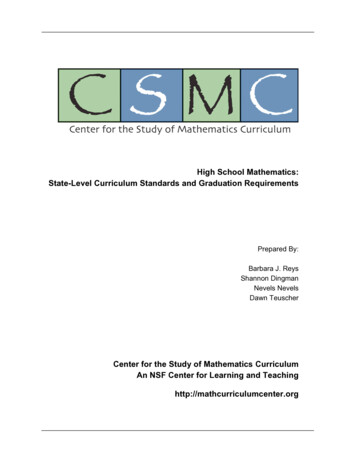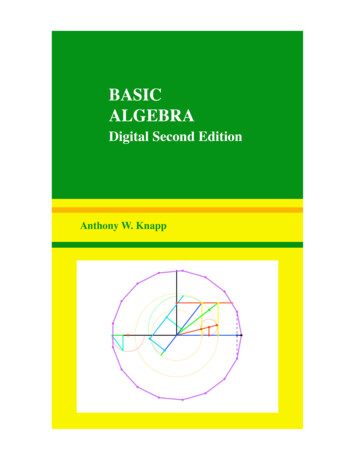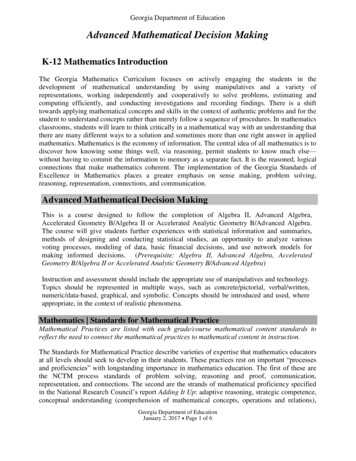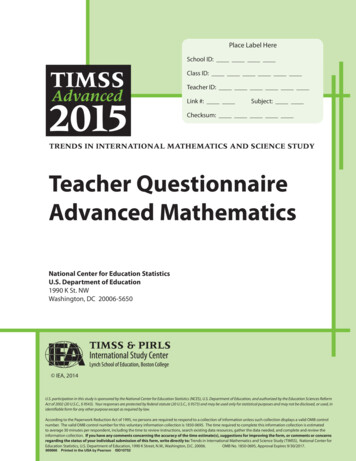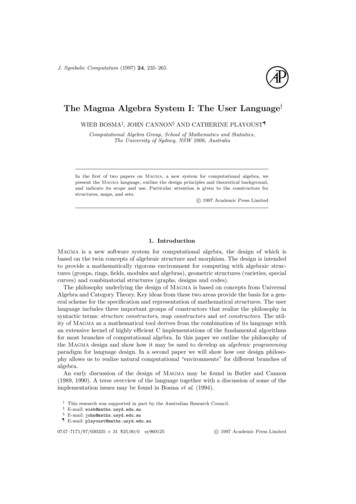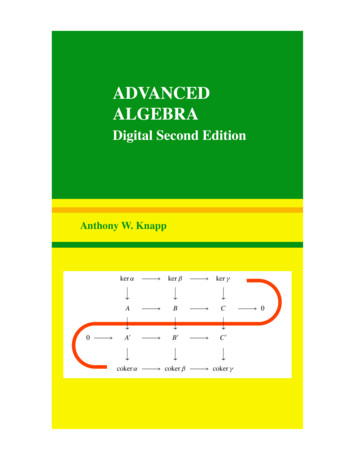
Transcription
Advanced Algebra
Digital Second EditionsBy Anthony W. KnappBasic AlgebraAdvanced AlgebraBasic Real Analysis,with an appendix “Elementary Complex Analysis”Advanced Real Analysis
Anthony W. KnappAdvanced AlgebraAlong with a Companion Volume Basic AlgebraDigital Second Edition, 2016Published by the AuthorEast Setauket, New York
Anthony W. Knapp81 Upper Sheep Pasture RoadEast Setauket, N.Y. 11733–1729, U.S.A.Email to: aknapp@math.stonybrook.eduHomepage: www.math.stonybrook.edu/ aknappTitle: Basic AlgebraCover: Construction of a regular heptadecagon, the steps shown in color sequence; see page 505.Mathematics Subject Classification (2010): 15–01, 20–01, 13–01, 12–01, 16–01, 08–01, 18A05,68P30.First Edition, ISBN-13 978-0-8176-3248-9c 2006 Anthony W. KnappPublished by Birkhäuser BostonDigital Second Edition, not to be sold, no ISBNc 2016 Anthony W. KnappPublished by the AuthorAll rights reserved. This file is a digital second edition of the above named book. The text, images,and other data contained in this file, which is in portable document format (PDF), are proprietary tothe author, and the author retains all rights, including copyright, in them. The use in this file of tradenames, trademarks, service marks, and similar items, even if they are not identified as such, is notto be taken as an expression of opinion as to whether or not they are subject to proprietary rights.All rights to print media for the first edition of this book have been licensed to Birkhäuser Boston,c/o Springer Science Business Media Inc., 233 Spring Street, New York, NY 10013, USA, andthis organization and its successor licensees may have certain rights concerning print media for thedigital second edition. The author has retained all rights worldwide concerning digital media forboth the first edition and the digital second edition.The file is made available for limited noncommercial use for purposes of education, scholarship, andresearch, and for these purposes only, or for fair use as understood in the United States copyright law.Users may freely download this file for their own use and may store it, post it online, and transmit itdigitally for purposes of education, scholarship, and research. They may not convert it from PDF toany other format (e.g., EPUB), they may not edit it, and they may not do reverse engineering with it.In transmitting the file to others or posting it online, users must charge no fee, nor may they includethe file in any collection of files for which a fee is charged. Any exception to these rules requireswritten permission from the author.Except as provided by fair use provisions of the United States copyright law, no extracts or quotationsfrom this file may be used that do not consist of whole pages unless permission has been granted bythe author (and by Birkhäuser Boston if appropriate).The permission granted for use of the whole file and the prohibition against charging fees extend toany partial file that contains only whole pages from this file, except that the copyright notice on thispage must be included in any partial file that does not consist exclusively of the front cover page.Such a partial file shall not be included in any derivative work unless permission has been grantedby the author (and by Birkhäuser Boston if appropriate).Inquiries concerning print copies of either edition should be directed to Springer Science BusinessMedia Inc.iv
To SusanandTo My Children, Sarah and William,andTo My Algebra Teachers:Ralph Fox, John Fraleigh, Robert Gunning,John Kemeny, Bertram Kostant, Robert Langlands,Goro Shimura, Hale Trotter, Richard Williamson
CONTENTSContents of Basic AlgebraPreface to the Second EditionPreface to the First EditionList of FiguresDependence among ChaptersGuide for the ReaderNotation and TerminologyxxixiiixviixviiixixxxiiiI.TRANSITION TO MODERN NUMBER THEORY1. Historical Background2. Quadratic Reciprocity3. Equivalence and Reduction of Quadratic Forms4. Composition of Forms, Class Group5. Genera6. Quadratic Number Fields and Their Units7. Relationship of Quadratic Forms to Ideals8. Primes in the Progressions 4n 1 and 4n 39. Dirichlet Series and Euler Products10. Dirichlet’s Theorem on Primes in Arithmetic Progressions11. ProblemsII.WEDDERBURN–ARTIN RING THEORY1. Historical Motivation2. Semisimple Rings and Wedderburn’s Theorem3. Rings with Chain Condition and Artin’s Theorem4. Wedderburn–Artin Radical5. Wedderburn’s Main Theorem6. Semisimplicity and Tensor Products7. Skolem–Noether Theorem8. Double Centralizer Theorem9. Wedderburn’s Theorem about Finite Division Rings10. Frobenius’s Theorem about Division Algebras over the Reals11. 114117118120
viiiContentsIII. BRAUER GROUP1. Definition and Examples, Relative Brauer Group2. Factor Sets3. Crossed Products4. Hilbert’s Theorem 905. Digression on Cohomology of Groups6. Relative Brauer Group when the Galois Group Is Cyclic7. Problems123124132135145147158162IV.HOMOLOGICAL ALGEBRA1. Overview2. Complexes and Additive Functors3. Long Exact Sequences4. Projectives and Injectives5. Derived Functors6. Long Exact Sequences of Derived Functors7. Ext and Tor8. Abelian Categories9. Problems166167171184192202210223232250V.THREE THEOREMS IN ALGEBRAIC NUMBER THEORY1. Setting2. Discriminant3. Dedekind Discriminant Theorem4. Cubic Number Fields as Examples5. Dirichlet Unit Theorem6. Finiteness of the Class Number7. N WITH ADELES AND IDELES1. p-adic Numbers2. Discrete Valuations3. Absolute Values4. Completions5. Hensel’s Lemma6. Ramification Indices and Residue Class Degrees7. Special Features of Galois Extensions8. Different and Discriminant9. Global and Local Fields10. Adeles and Ideles11. Problems313314320331342349353368371382388397
ContentsixVII. INFINITE FIELD EXTENSIONS1. Nullstellensatz2. Transcendence Degree3. Separable and Purely Inseparable Extensions4. Krull Dimension5. Nonsingular and Singular Points6. Infinite Galois Groups7. Problems403404408414423428434445VIII. BACKGROUND FOR ALGEBRAIC GEOMETRY1. Historical Origins and Overview2. Resultant and Bezout’s Theorem3. Projective Plane Curves4. Intersection Multiplicity for a Line with a Curve5. Intersection Multiplicity for Two Curves6. General Form of Bezout’s Theorem for Plane Curves7. Gröbner Bases8. Constructive Existence9. Uniqueness of Reduced Gröbner Bases10. Simultaneous Systems of Polynomial Equations11. Problems447448451456466473488491499508510516IX.THE NUMBER THEORY OF ALGEBRAIC CURVES1. Historical Origins and Overview2. Divisors3. Genus4. Riemann–Roch Theorem5. Applications of the Riemann–Roch Theorem6. Problems520520531534540552554X.METHODS OF ALGEBRAIC GEOMETRY1. Affine Algebraic Sets and Affine Varieties2. Geometric Dimension3. Projective Algebraic Sets and Projective Varieties4. Rational Functions and Regular Functions5. Morphisms6. Rational Maps7. Zariski’s Theorem about Nonsingular Points8. Classification Questions about Irreducible Curves9. Affine Algebraic Sets for Monomial Ideals10. Hilbert Polynomial in the Affine Case558559563570579590595600604618626
xX.ContentsMETHODS OF ALGEBRAIC GEOMETRY (Continued)11. Hilbert Polynomial in the Projective Case12. Intersections in Projective Space13. Schemes14. Problems633635638644Hints for Solutions of ProblemsSelected ReferencesIndex of NotationIndex649713717721CONTENTS OF BASIC s about the Integers, Polynomials, and MatricesVector Spaces over Q, R, and CInner-Product SpacesGroups and Group ActionsTheory of a Single Linear TransformationMultilinear AlgebraAdvanced Group TheoryCommutative Rings and Their ModulesFields and Galois TheoryModules over Noncommutative Rings
PREFACE TO THE SECOND EDITIONIn the years since publication of the first editions of Basic Algebra and AdvancedAlgebra, many readers have reacted to the books by sending comments, suggestions, and corrections. They appreciated the overall comprehensive nature of thebooks, associating this feature with the large number of problems that develop somany sidelights and applications of the theory.Along with the general comments and specific suggestions were corrections,and there were enough corrections to the first volume to warrant a second edition.A second edition of Advanced Algebra was then needed for compatibility.For the first editions, the author granted a publishing license to BirkhäuserBoston that was limited to print media, leaving the question of electronic publication unresolved. The main change with the second editions is that the questionof electronic publication has now been resolved, and for each book a PDF file,called the “digital second edition,” is being made freely available to everyoneworldwide for personal use. These files may be downloaded from the author’sown Web page and from elsewhere.Some adjustments to Advanced Algebra were made at the time of the revisionof Basic Algebra. These consisted of a small number of changes to the textnecessitated by alterations to Basic Algebra, the correction of a few misprints,one small amendment to the “Guide for the Reader” about Chapter VII, someupdates to the References, and some additions to the index for completeness. Noother changes were made.Ann Kostant was the person who conceived the idea, about 2003, for Birkhäuserto have a series Cornerstones. Her vision was to enlist authors experienced atmathematical exposition who would write compatible texts at the early graduatelevel. The overall choice of topics was heavily influenced by the graduate curriculaof major American universities. The idea was for each book in the series to explainwhat the young mathematician needs to know about a swath of mathematics inorder to communicate well with colleagues in all branches of mathematics in the21st century. Taken together, the books in the series were intended as an antidotefor the worst effects of overspecialization. I am honored to have been part of herproject.It was Benjamin Levitt, Birkhäuser mathematics editor in New York as of 2014,who encouraged the writing of second editions of the algebra books. He made anumber of suggestions about pursuing them, and he passed along comments fromxi
xiiPreface to the Second Editionseveral anonymous referees about the strengths and weaknesses of each book. Iam especially grateful to those readers who have sent me comments over theyears. The typesetting was done by the program Textures using AMS-TEX, andthe figures were drawn with Mathematica.As with the first editions, I invite corrections and other comments about thesecond editions from readers. For as long as I am able, I plan to point to lists ofknown corrections from my own Web page, www.math.stonybrook.edu/ aknapp.A. W. KNAPPJanuary 2016
PREFACE TO THE FIRST EDITIONAdvanced Algebra and its companion volume Basic Algebra systematically develop concepts and tools in algebra that are vital to every mathematician, whetherpure or applied, aspiring or established. The two books together aim to give thereader a global view of algebra, its use, and its role in mathematics as a whole.The idea is to explain what the young mathematician needs to know about algebrain order to communicate well with colleagues in all branches of mathematics.The books are written as textbooks, and their primary audience is studentswho are learning the material for the first time and who are planning a career inwhich they will use advanced mathematics professionally. Much of the materialin the two books, including nearly all of Basic Algebra and some of AdvancedAlgebra, corresponds to normal course work, with the proportions depending onthe university. The books include further topics that may be skipped in requiredcourses but that the professional mathematician will ultimately want to learn byself-study. The test of each topic for inclusion is whether it is something that aplenary lecturer at a broad international or national meeting is likely to take asknown by the audience.Key topics and features of Advanced Algebra are as follows: Topics build on the linear algebra, group theory, factorization of ideals, structure of fields, Galois theory, and elementary theory of modules developed inBasic Algebra. Individual chapters treat various topics in commutative and noncommutativealgebra, together providing introductions to the theory of associative algebras,homological algebra, algebraic number theory, and algebraic geometry. The text emphasizes connections between algebra and other branches of mathematics, particularly topology and complex analysis. All the while, it carriesalong two themes from Basic Algebra: the analogy between integers andpolynomials in one variable over a field, and the relationship between numbertheory and geometry. Several sections in two chapters introduce the subject of Gröbner bases, whichis the modern gateway toward handling simultaneous polynomial equations inapplications. The development proceeds from the particular to the general, often introducingexamples well before a theory that incorporates them.xiii
xivPreface to the First Edition More than 250 problems at the ends of chapters illuminate aspects of the text,develop related topics, and point to additional applications. A separate section“Hints for Solutions of Problems” at the end of the book gives detailed hintsfor most of the problems, complete solutions for many.It is assumed that the reader is already familiar with linear algebra, grouptheory, rings and modules, unique factorization domains, Dedekind domains,fields and algebraic extension fields, and Galois theory at the level discussed inBasic Algebra. Not all of this material is needed for each chapter of AdvancedAlgebra, and chapter-by-chapter information about prerequisites appears in theGuide for the Reader beginning on page xvii.Historically the subjects of algebraic number theory and algebraic geometryhave influenced each other as they have developed, and the present book tries tobring out this interaction to some extent. It is easy to see that there must be a closeconnection. In fact, one number-theory problem already solved by Fermat andEuler was to find all pairs (x, y) of integers satisfying x 2 y 2 n, where n is agiven positive integer. More generally one can consider higher-order equationsof this kind, such as y 2 x 3 8x. Even this simple change of degree has a greateffect on the difficulty, so much so that one is inclined first to solve an easierproblem: find the rational pairs satisfying the equation. Is the search for rationalsolutions a problem in number theory or a problem about a curve in the plane? Theanswer is that really it is both. We can carry this kind of question further. Insteadof considering solutions of a single polynomial equation in two variables, wecan consider solutions of a system of polynomial equations in several variables.Within the system no individual equation is an intrinsic feature of the problembecause one of the equations can always be replaced by its sum with another ofthe equations; if we regard each equation as an expression set equal to 0, thenthe intrinsic problem is to study the locus of common zeros of the equations.This formulation of the problem sounds much more like algebraic geometry thannumber theory.A doubter might draw a distinction between integer solutions and rationalsolutions, saying that finding integer solutions is number theory while findingrational solutions is algebraic geometry. Experience shows that this is an artificialdistinction. Although algebraic geometry was initially developed as a subject thatstudies solutions for which the variables take values in a field, particularly in analgebraically closed field, the insistence on working only with fields imposedartificial limitations on how problems could be approached. In the late 1950s andearly 1960s the foundations of the subject were transformed by allowing variablesto take values in an arbitrary commutative ring with identity. The very end of thisbook aims to give some idea of what those new foundations are.Along the way we shall observe parallels between number theory and algebraicgeometry, even as we nominally study one subject at a time. The book begins with
Preface to the First Editionxva chapter on those aspects of number theory that mark the historical transitionfrom classical number theory to modern algebraic number theory. Chapter I dealswith three celebrated advances of Gauss and Dirichlet in classical number theorythat one might wish to generalize by means of algebraic number theory. Thedetailed level of knowledge that one gains about those topics can be regarded asa goal for the desired level of understanding about more complicated problems.Chapter I thus establishes a framework for the whole book.Associative algebras are the topic of Chapters II and III. The tools for studyingsuch algebras provide methods for classifying noncommutative division rings.One such tool, known as the Brauer group, has a cohomological interpretationthat ties the subject to algebraic number theory.Because of other work done in the 1950s, homology and cohomology can beabstracted in such a way that the theory impacts several fields simultaneously,including topology and complex analysis. The resulting subject is called homological algebra and is the topic of Chapter IV. Having cohomology available at thispoint of the present book means that one is prepared to use it both in algebraicnumber theory and in situations in algebraic geometry that have grown out ofcomplex analysis.The last six chapters are about algebraic number theory, algebraic geometry,and the relationship between them. Chapters V–VI concern the three mainfoundational theorems in algebraic number theory. Chapter V goes at theseresults in a direct fashion but falls short of giving a complete proof in one case.Chapter VI goes at matters more indirectly. It explores the parallel betweennumber theory and the theory of algebraic curves, makes use of tools from analysisconcerning compactness and completeness, succeeds in giving full proofs of thethree theorems of Chapter V, and introduces the modern approach via adeles andideles to deeper questions in these subject areas.Chapters VII–X are about algebraic geometry. Chapter VII fills in someprerequisites from the theories of fields and commutative rings that are needed toset up the foundations of algebraic geometry. Chapters VIII–X concern algebraicgeometry itself. They come at the subject successively from three points ofview—from the algebraic point of view of simultaneous systems of polynomialequations in several variables, from the number-theoretic point of view suggestedby the classical theory of Riemann surfaces, and from the geometric point of view.The topics most likely to be included in normal course work include theWedderburn theory of semisimple algebras in Chapter II, homological algebrain Chapter IV, and some of the advanced material on fields in Chapter VII. Achart on page xvi tells the dependence of chapters on earlier chapters, and, asmentioned above, the section Guide for the Reader tells what knowledge of BasicAlgebra is assumed for each chapter.The problems at the ends of chapters are intended to play a more important
xviPreface to the First Editionrole than is normal for problems in a mathematics book. Almost all problems aresolved in the section of hints at the end of the book. This being so, some blocks ofproblems form additional topics that could have been included in the text but werenot; these blocks may be regarded as optional topics, or they may be treated aschallenges for the reader. The optional topics of this kind usually either carry outfurther development of the theory or introduce significant applications to otherbranches of mathematics. For example a number of applications to topology aretreated in this way.Not all problems are of this kind, of course. Some of the problems arereally pure or applied theorems, some are examples showing the degree to whichhypotheses can be stretched, and a few are just exercises. The reader gets noindication which problems are of which type, nor of which ones are relativelyeasy. Each problem can be solved with tools developed up to that point in thebook, plus any additional prerequisites that are noted.The theorems, propositions, lemmas, and corollaries within each chapter areindexed by a single number stream. Figures have their own number stream, andone can find the page reference for each figure from the table on page xv. Labelson displayed lines occur only within proofs and examples, and they are local to theparticular proof or example in progress. Each occurrence of the word “PROOF”or “PROOF” is matched by an occurrence at the right margin of the symbol tomark the end of that proof.I am grateful to Ann Kostant and Steven Krantz for encouraging this projectand for making many suggestions about pursuing it, and I am indebted to DavidKramer, who did the copyediting. The typesetting was by AMS-TEX, and thefigures were drawn with Mathematica.I invite corrections and other comments from readers. I plan to maintain a listof known corrections on my own Web page.A. W. KNAPPAugust 2007
LIST OF .A cochain mapSnake diagramEnlarged snake diagramDefining property of a projectiveDefining property of an injectiveFormation of derived functorsUniversal mapping property of a kernel of a morphismUniversal mapping property of a cokernel of a morphismThe pullback of a pair of morphismsCommutativity of completion and extension as field mappingsCommutativity of completion and extension as homomorphismsof valued fieldsxvii154185185192195205235236243356360
DEPENDENCE AMONG CHAPTERSBelow is a chart of the main lines of dependence of chapters on prior chapters.The dashed lines indicate helpful motivation but no logical dependence. Apartfrom that, particular examples may make use of information from earlier chaptersthat is not indicated by the .6VIII.7toVIII.10III.6Prop. 2.29toProp. viiiVIII.1toVIII.3Lemma7.21VIII.4toVIII.6
GUIDE FOR THE READERThis section is intended to help the reader find out what parts of each chapter aremost important and how the chapters are interrelated. Further information of thiskind is contained in the abstracts that begin each of the chapters.The book treats its subject material as pointing toward algebraic numbertheory and algebraic geometry, with emphasis on aspects of these subjects thatimpact fields of mathematics other than algebra. Two chapters treat the theoryof associative algebras, not necessarily commutative, and one chapter treatshomological algebra; both these topics play a role in algebraic number theory andalgebraic geometry, and homological algebra plays an important role in topologyand complex analysis. The constant theme is a relationship between numbertheory and geometry, and this theme recurs throughout the book on differentlevels.The book assumes knowledge of most of the content of Basic Algebra, eitherfrom that book itself or from some comparable source. Some of the less standardresults that are needed from Basic Algebra are summarized in the section Notationand Terminology beginning on page xxi. The assumed knowledge of algebraincludes facility with using the Axiom of Choice, Zorn’s Lemma, and elementaryproperties of cardinality. All chapters of the present book but the first assumeknowledge of Chapters I–IV of Basic Algebra other than the Sylow Theorems,facts from Chapter V about determinants and characteristic polynomials andminimal polynomials, simple properties of multilinear forms from Chapter VI,the definitions and elementary properties of ideals and modules from Chapter VIII,the Chinese Remainder Theorem and the theory of unique factorization domainsfrom Chapter VIII, and the theory of algebraic field extensions and separabilityand Galois groups from Chapter IX. Additional knowledge of parts of BasicAlgebra that is needed for particular chapters is discussed below. In addition,some sections of the book, as indicated below, make use of some real or complexanalysis. The real analysis in question generally consists in the use of infiniteseries, uniform convergence, differential calculus in several variables, and somepoint-set topology. The complex analysis generally consists in the fundamentalsof the one-variable theory of analytic functions, including the Cauchy IntegralFormula, expansions in convergent power series, and analytic continuation.The remainder of this section is an overview of individual chapters and groupsof chapters.xix
xxGuide for the ReaderChapter I concerns three results of Gauss and Dirichlet that marked a transitionfrom the classical number theory of Fermat, Euler, and Lagrange to the algebraicnumber theory of Kummer, Dedekind, Kronecker, Hermite, and Eisenstein. Theseresults are Gauss’s Law of Quadratic Reciprocity, the theory of binary quadraticforms begun by Gauss and continued by Dirichlet, and Dirichlet’s Theorem onprimes in arithmetic progressions. Quadratic reciprocity was a necessary preliminary for the theory of binary quadratic forms. When viewed as giving informationabout a certain class of Diophantine equations, the theory of binary quadraticforms gives a gauge of what to hope for more generally. The theory anticipatesthe definition of abstract abelian groups, which occurred later historically, andit anticipates the definition of the class number of an algebraic number field, atleast in the quadratic case. Dirichlet obtained formulas for the class numbersthat arise from binary quadratic forms, and these formulas led to the method bywhich he proved his theorem on primes in arithmetic progressions. Much of thechapter uses only elementary results from Basic Algebra. However, Sections 6–7use facts about quadratic number fields, including the multiplication of idealsin their rings of integers, and Section 10 uses the Fourier inversion formula forfinite abelian groups, which is in Section VII.4 of Basic Algebra. Sections 8–10make use of a certain amount of real and complex analysis concerning uniformconvergence and properties of analytic functions.Chapters II–III introduce the theory of associative algebras over fields. Chapter II includes the original theory of Wedderburn, including an amplification byE. Artin, while Chapter III introduces the Brauer group and connects the theorywith the cohomology of groups. The basic material on simple and semisimpleassociative algebras is in Sections 1–3 of Chapter II, which assumes familiaritywith commutative Noetherian rings as in Chapter VIII of Basic Algebra, plus thematerial in Chapter X on semisimple modules, chain conditions for modules, andthe Jordan–Hölder Theorem. Sections 4–6 contain the statement and proof ofWedderburn’s Main Theorem, telling the structure of general finite-dimensionalassociative algebras in characteristic 0. These sections include a relatively selfcontained segment from Proposition 2.29 through Proposition 2.33 on the roleof separability in the structure of tensor products of algebras. This material is thepart of Sections 4–6 that is used in the remainder of the chapter to analyze finitedimensional associative division algebras over fields. Two easy consequences ofthis analysis are Wedderburn’s Theorem that every finite division ring is commutative and Frobenius’s Theorem that the only finite-dimensional associativedivision algebras over R are R, C, and the algebra H of quaternions, up to Risomorphism.Chapter III introduces the Brauer group to parametrize the isomorphism classesof finite-dimensional associative division algebras whose center is a given field.Sections 2–3 exhibit an isomorphism of a relative Brauer group with what turns
Guide for the Readerxxiout to be a cohomology group in degree 2. This development runs parallel tothe theory of factor sets for groups as in Chapter VII of Basic Algebra, andsome familiarity with that theory can be helpful as motivation. The case that therelative Brauer group is cyclic is of special importance, and the theory is used inthe problems to construct examples of division rings that would not have beenotherwise available. The chapter makes use of material from Chapter X of BasicAlgebra on the tensor product of algebras and on complexes and exact sequences.Chapter IV is about homological algebra, with emphasis on connecting homomorphisms, long exact sequences, and derived functors. All but the last section isdone in the context of “good” categories of unital left R modules, R being a ringwith identity, where it is possible to work with individual elements in each object.The reader is expected to be familiar with some example for motivation; this canbe knowledge of cohomology of groups at the level of Section III.5, or it can besome experience from topology or from the cohomology of Lie algebras as treatedin other books. Knowledge of complexes and exact sequences from Chapter Xof Basic Algebra is prerequisite. Homological algebra properly belongs in thisbook because it is fundamental in topology and complex analysis; in algebraits role becomes significant just beyond the level of the current book. Importantapplications are not limited in practice to “good” categories; “sheaf” cohomologyis an example with significant applications that does not fit this mold. Section 8sketches the theory of homological algebra in the context of “abelian” categories.In this case one does not have individual elements at hand, but some substitute isstill possible; sheaf cohomology can be treated in this context.Chapters V and VI are an introduction to algebraic number theory. The theoryof Dedekind domains from Chapters VIII and IX of Basic Algebra is taken asknown, along with kn
which they will use advanced mathematics professionally. Much of the material in the two books, including nearly all of Basic Algebra and some of Advanced Algebra, correspondsto normal course work, with the proportionsdepending on the university. The boo
